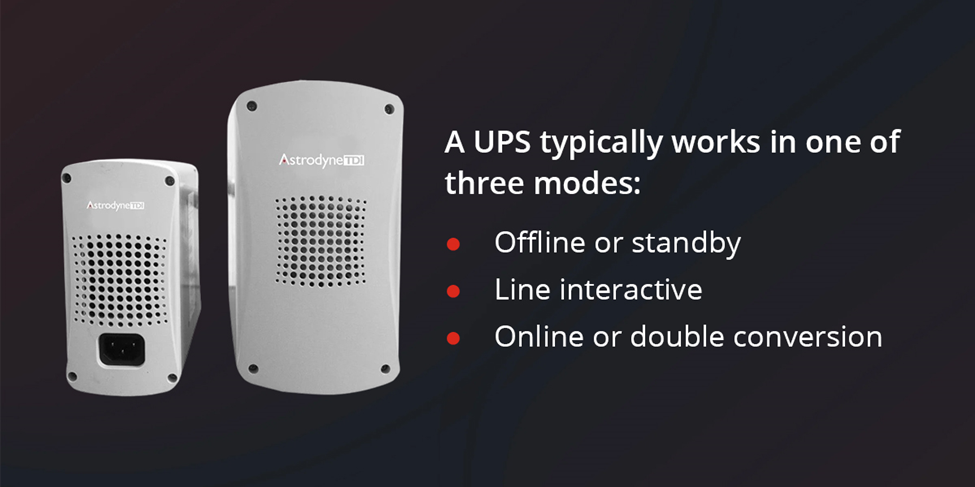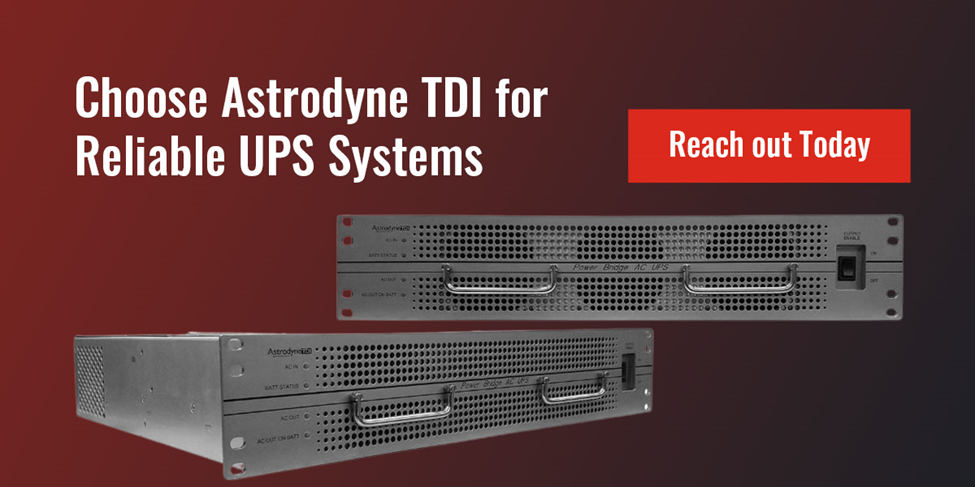RESOURCES
How Do Uninterruptible Power Supplies Work?
An uninterruptible power supply (UPS) is a crucial facility infrastructure from surgical suites to international enterprises and mission-critical military operations. UPS systems deliver real-time backup power when a regular grid power source fails, allowing users to continue the process. In addition, they provide clean energy, which prevents damage to electronic sub-systems.
UPS systems come in several styles, each well-suited to specific applications and power demands. Let's explore how a UPS works and keeps operations moving.
UPS System Parts and Styles
In addition to the typical components of a power supply, a UPS system includes the following parts:
- Battery: One of the most essential parts of a UPS is the battery, which can be built into the UPS or installed externally. The battery size generally dictates how long the UPS will provide power when in backup mode.
- Charger or rectifier: The charger uses DC power to charge the battery and supply power to the inverter.
- Inverter: The inverter converts incoming power from the grid to clean AC power. It suppresses voltage abnormalities like surges and sags and maintains a clean and stable AC output. When AC power fails, the inverter converts the Battery's DC voltage to clean AC power. This clean and durable power goes a long way in enhancing the life of electronic equipment.
- Static switch: A static switch transfers the load to and from the inverter and the utility without interrupting the power supply. This optional feature is intended to revert power to the grid when the UPS system fails. This ensures the system is not entirely down while efforts are made to replace the failed UPS system.
UPS systems are available in floor stand-alone or rack-mounted styles. A rack-mounted UPS fits into standard IT racks and other enclosures for easy equipment connections, supplying power to other elements in the rack, such as servers.
Another part you might find alongside a UPS is a power distribution unit (PDU). A PDU can control and distribute power to various equipment, but the UPS supplies it.
What Are UPS Batteries Made of?
Lithium-ion and sealed lead acid (SLA) batteries are most commonly used in modern UPS systems. Lithium-ion is generally the better option, outperforming SLA batteries in many areas. Lithium ion-ion batteries have one of the highest energy densities available, and they can support high-power needs for short durations when needed. They have a low internal loss and don’t exhibit memory effects associated with some of the older battery types.
Other benefits of lithium-ion batteries include longer lifespans, lower weight, fast charging, and a very long life, typically ten years.

UPS Operation Modes
A UPS typically works in one of three modes:
- Offline or standby: An offline UPS will switch to battery power when the incoming power drops or goes outside acceptable ranges, such as during a power outage, voltage sag, or voltage surge. Standby UPS systems are the most basic style. They have a slight delay, usually around 0-10 milliseconds. While this is typically fast enough to keep entry-level systems running, it is too long for sensitive or mission-critical electronics. These are generally adequate for home computers but not recommended for critical systems like cash registers, data centers, cell phone towers, military, etc.
- Online or double conversion: A double-conversion UPS offers near-perfect synthesized AC power, even if the incoming power is lower quality. These systems use a combination of a rectifier and inverter to convert incoming AC to DC and then invert DC to AC. The battery is always in the circuit but is switched in as soon as incoming AC power goes down. Since there is no delay mechanism, they have zero transfer time. In other words, the load system always gets clean AC power from the UPS and never directly from the wall power. These systems cost more than Offline UPS systems, but they are the best fit for mission-critical systems in data centers, secure communications, emergency management, etc.
When deciding if you need a UPS, consider factors like:
- The cost of the equipment and potential downtime
- The sensitivity of the equipment to poor-quality power
- Whether the equipment supports mission-critical operations

Choose Astrodyne TDI for Reliable UPS Systems
At Astrodyne TDI, we build UPS systems for whatever your work entails. From rugged UPS systems in industrial environments to those powering sensitive data centers or healthcare equipment, our expertise puts cutting-edge products on your side. We put quality first for dependable systems that answer even the most unique demands. We offer a range of diverse and configurable UPS systems, and we can custom-build a unit for your application.
Browse our UPS systems or reach out today to discuss finding or building the right one.

